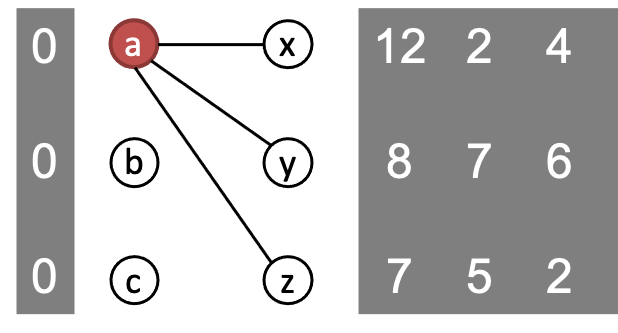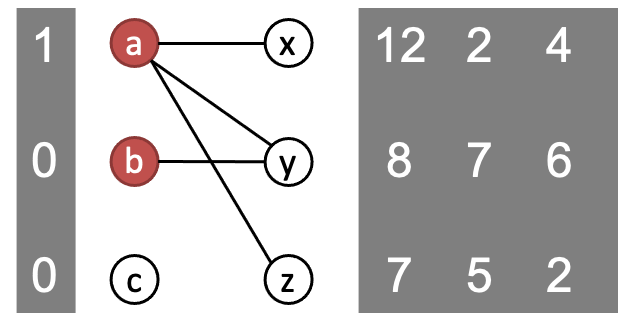<< 返回本书主页<< Back to the afterword page
5 匹配市场
Jan. 2022
5.1 背景问题
偏好卖家图
亚当斯密提出,市场经济就像有一个“无形之手”,把各方都安排妥当。本节课我们的任务就是把这一理论模型化。
考虑如下一个情境:要把一堆物品分配给一群人,不同人的偏好可能发生冲突,如何分配是最优的?为了简化问题,我们考虑一个更具体的情境:把
我们把每个人对每个物品的偏好,抽象为一个出价(估值)矩阵,买家
为了更形象地表示这一市场里每个人的的偏好情况,我们用一个二部图表示买家和物品,下图中左侧节点为物品(或“卖家”),右侧节点为买家。对于每一买家

如果这一二部图里,每个买家的偏好恰好互不冲突,这一市场就存在“合理分配”。
以“物以稀为贵”促成“合理匹配”
对于一个特定的市场,亦即,对于特定的价格矩阵和特定的出价矩阵,不一定存在“合理分配”。为了解决这一问题,我们需要引入一个新的理论假设,“物以稀为贵”:如果买家的一个子集S所表达的偏好物品子集N(S)比S小,说明N(S)中的物品没法在S中无冲突地安排,意味着“稀有了”“紧俏了”,于是应该加价。这样的S称为“受限组”。
以“物以稀为贵”促成“合理匹配”的全过程就是,对全市场里所有紧俏的物品如此操作,不断迭代,直到这一市场存在“合理分配”。
我们设所有物品的初始价格为
以下图为例,

物品

迭代操作,直到该市场存在合理分配,没有买家受限。
这一市场在价格向量为

p.s. 当一个情境存在多个受限组时,选择哪一个受限组进行操作可能会影响最终的清仓价格,这意味着清仓价格不唯一。
对匹配算法的反思
我们可以证明,如此找出的合理分配,实现了社会福利的最大化。
给定清仓价格(
对于任意一种分配方式,总有:
因此,
给定一组价格,匹配算法取到
这个算法有更广泛的应用:
- 给定一个
- 每个人给出自己的偏好序列,我们也可以依据这一偏好人为地赋值,从而使用这一算法进行物品分配。
另一个问题是,为什么提价时我们以
此外,匹配算法过程总能结束,我们可以给出一个数学证明。
定义一个势能函数:
在匹配算法运行过程中,
但
总之,我们把经济学中的经典概念,例如理性人、价格、供需关系、物以稀为贵、均衡、社会最优,做出了生动的表达,使用的是简单图论语言和计算过程描述,例如偏好卖家图、受限组、迭代调整价格、结束条件。
5.2 计算实践:实现匹配市场算法
5.2.1 作业描述与算法思路
为了把这一模型放在一个更具体的场景中,李老师给全班的同学发放问卷,让班上的11个同学给出对11本书的出价,得到具体的出价矩阵如下:
| 序号 | 西方哲学史 | 中国历代政治得失 | 尤利西斯 | 致命的自负 | 车浩的刑法题 | 深度学习 | 时间序列分析 | 期权、期货及其他衍生产品 | 红书 | 历史的逻辑 | 海德格尔哲学概论 |
|---|---|---|---|---|---|---|---|---|---|---|---|
| 1 | 0 | 0 | 10 | 5 | 0 | 25 | 20 | 10 | 0 | 0 | 0 |
| 2 | 5 | 10 | 1 | 1 | 0 | 40 | 4 | 0 | 55 | 10 | 30 |
| 3 | 0 | 0 | 0 | 10 | 0 | 0 | 0 | 5 | 0 | 5 | 0 |
| 4 | 20 | 0 | 60 | 20 | 0 | 60 | 0 | 0 | 0 | 30 | 10 |
| 5 | 40 | 10 | 30 | 20 | 5 | 25 | 40 | 0 | 35 | 30 | 13 |
| 6 | 10 | 10 | 0 | 10 | 20 | 0 | 20 | 0 | 0 | 20 | 10 |
| 7 | 55 | 30 | 50 | 10 | 0 | 50 | 50 | 0 | 80 | 20 | 30 |
| 8 | 0 | 0 | 0 | 0 | 0 | 30 | 30 | 70 | 0 | 0 | 0 |
| 9 | 0 | 20 | 10 | 15 | 30 | 15 | 0 | 0 | 5 | 5 | 0 |
| 10 | 10 | 0 | 0 | 35 | 0 | 10 | 55 | 45 | 0 | 0 | 0 |
| 11 | 20 | 10 | 20 | 0 | 0 | 10 | 0 | 0 | 0 | 10 | 20 |
本次作业就是找出以上市场的最优匹配。我们输入以上估值矩阵,输出一组清仓价格、对应的偏好卖家图(二部图)上的一个完整匹配、对应的社会最优(值)。
根据前文,先设所有书的初始价格为零,根据估值矩阵和价格矩阵确定偏好卖家图,判断合理匹配是否存在,如果存在就输出合理匹配,不存在就找出受限组邻居(大家都想要的物品),对受限者邻居提高一个单位的价格。迭代运行以上算法,直到实现完整匹配。
编程中存在几个难点:
- 如何判断当前市场中是否存在完整匹配?如果不存在,如何返回一个受限组和其对应的受限组邻居?这一部分不在我们的作业要求中,李老师给了我们一个函数
perfect_match供调用。 - 如何根据估值矩阵或价格矩阵生成偏好卖家图?首先要找出买家
5.2.2 编程实现与要点说明
李老师提供了perfect_match函数:输入表示偏好卖家图的二部图,如果存在完整匹配,返回True和完整匹配边集{ (i,matched[i]) for i in range(n) };如果不存在,返回False和一个受限组邻居{matched[n] for n in bfs_queue if n != i}。
xxxxxxxxxx511"""2程序提供perfect_match函数,该函数接收一个2n个节点二部图的邻接矩阵,前n个节点可认为二部图左部,后n个节点为右部。3若存在完美匹配,函数返回真及一个完美匹配的边集合,否则返回假并给出右部节点的一个受限集关联的左部邻居节点集合。4基本思路为对左部未匹配节点作交替BFS,找增广路径,详见教材10.6或"匈牙利算法"。5"""6def perfect_match(matrix):7 node_num = len(matrix)8 node_left = node_num >> 19 # 邻接矩阵转化为邻接表,对稀疏图可提高下面循环的效率10 graph = [{i for i in range(node_num) if matrix[j][i] == 1} for j in range(node_num)]11 checked = [-1] * node_num # 记录某节点i是否已在checked[i]节点为根的先宽搜索树中12 prev = [-1] * node_num # 记录交替路径中某右部节点的上一个右部节点,左部节点已被matched记录13 matched = [-1] * node_num # 记录某节点匹配的节点14 for i in range(node_left, node_num):15 if matched[i] != -1: # i应是某尚未匹配的右部节点16 continue17 # 先宽搜索队列只记录右部节点,这些节点是左部节点通过已有匹配边一一对应来的18 bfs_queue = [i]19 pos = 0 # 记录遍历队列的当前位置20 flag = False # 一次搜索找到一条增广路径即完成21 prev[i] = -1 # i记录为路径起点22 while pos < len(bfs_queue) and not flag:23 node = bfs_queue[pos]24 # node是右部节点,j是与之相邻的左部节点25 for j in graph[node]:26 if checked[j] == i:27 continue28 checked[j] = i29 # 将j匹配的右部节点加入队列继续搜索30 if matched[j] > -1:31 bfs_queue.append(matched[j])32 prev[matched[j]] = node33 # j没有匹配的右部节点说明找到增广路径34 else:35 flag = True36 t1, t2 = node, j37 while t1 != -1:38 t3 = matched[t1]39 matched[t1] = t240 matched[t2] = t141 t1 = prev[t1]42 t2 = t343 if flag:44 break45 pos += 146 # 该右部节点无法匹配说明不存在完美匹配,此时搜索队列即组成一个受限组。47 # 因为i未能匹配说明前面没有从i出发找到增广路径,即i的搜索树中左部节点总是通过已有匹配一一对应到其他右部节点,48 # 因此这些右部节点和i恰比它们的邻居左部节点多149 if matched[i] == -1:50 return False, {matched[n] for n in bfs_queue if n != i}51 return True, {(i, matched[i]) for i in range(node_left)}我们的任务,就是要根据出价矩阵和价格矩阵生成偏好卖家图,调用perfect_match函数,对受限组邻居进行加价;迭代这一过程,直到出现完整匹配。
第一步仍然是读取文件中的出价矩阵,存储在numpy 2d-arraybids里,具体代码类似1.2.1.2,数据见5.2.1。初始价格为[0, 0, 0, 0, 0, 0, 0, 0, 0, 0, 0]。
根据出价矩阵和价格矩阵,我先生成一个表示偏好卖家图的二部图。
xxxxxxxxxx51round = 02while True:3 round += 14 print('- - - - - - - - - - - - - - - - - - round %i - - - - - - - - - - - - - - - - - -' % round)5 market = np.zeros((items + buyers,items + buyers))具体地,对于买家bid_item这一列表里(可能有多个)。
xxxxxxxxxx131 for i in range(buyers):2 diff_max = bids[i][0] - prices[0]3 bid_item = [0]4 for j in range(1, items):5 # the starting-point of comparison: the first item6 bid = bids[i][j]7 diff = bid - prices[j]8 # compare to get the most wanted item9 if diff > diff_max:10 diff_max = diff11 bid_item = [j]12 elif diff == diff_max:13 bid_item.append(j)market二部图里,前items个编码表示物品,剩下的编码表示买家。买家market二部图里就表示为
xxxxxxxxxx31 for k in bid_item:2 market[items + i][k] = 13 market[k][items + i] = 1生成二部图market后,我就可以调用perfect_match函数。当市场不存在完整匹配时,我就对perfect_match返回的受限组邻居nb_set进行提价。
xxxxxxxxxx81 if perfect_match(market)[0]:2 ...3 break4 print('未能清仓。Prices for the next round:', end = ' ')5 nb_set = perfect_match(market)[1]6 for i in nb_set:7 prices[i] += 1 8 print(prices)第一轮的运行结果如下:
xxxxxxxxxx21>>> - - - - - - - - - - - - - - - - - - round 1 - - - - - - - - - - - - - - - - - -2>>> 未能清仓。Prices for the next round: [0. 0. 0. 0. 0. 0. 0. 0. 1. 0. 0.]
迭代运行多轮,直到perfect_match(market)[0] = True,实现清仓。输出清仓价格:
xxxxxxxxxx31 if perfect_match(market)[0]: # succeed clearing2 print('清仓价格:', end = '')3 print(prices)xxxxxxxxxx11>>> 清仓价格:[10. 0. 10. 0. 0. 20. 15. 5. 35. 0. 10.]
接着就是输出匹配结果、计算社会福利。计算社会福利时,我需要把每个人为ta买到的商品的估值final_price加总。
xxxxxxxxxx141 wellBeing = 02 bought_dict = {}3 for item in perfect_match(market)[1]:4 bought = item[0]5 buyer = item[1] - buyers6 final_bid = bids[buyer][bought]7 final_price = prices[bought]8 final_diff = final_bid - final_price9 bought_dict[buyer] = [bought, final_price, final_diff]10 wellBeing += final_bid11 print('右边买家%i与左边卖家%i匹配,他该支付%i,得最大差价%i。' \12 % (buyer, bought, final_price, final_diff))13 print('优化的社会福利为:', end = '')14 print(wellBeing)具体结果如下:
xxxxxxxxxx121>>> 右边买家10与左边卖家1匹配,他该支付0,得最大差价10。2>>> 右边买家8与左边卖家4匹配,他该支付0,得最大差价30。3>>> 右边买家4与左边卖家0匹配,他该支付10,得最大差价30。4>>> 右边买家2与左边卖家3匹配,他该支付0,得最大差价10。5>>> 右边买家0与左边卖家5匹配,他该支付20,得最大差价5。6>>> 右边买家1与左边卖家10匹配,他该支付10,得最大差价20。7>>> 右边买家7与左边卖家7匹配,他该支付5,得最大差价65。8>>> 右边买家9与左边卖家6匹配,他该支付15,得最大差价40。9>>> 右边买家5与左边卖家9匹配,他该支付0,得最大差价20。10>>> 右边买家6与左边卖家8匹配,他该支付35,得最大差价45。11>>> 右边买家3与左边卖家2匹配,他该支付10,得最大差价50。12>>> 优化的社会福利为:430
另外,我还提供了查询每个人应该买什么书的代码:
xxxxxxxxxx121 if fname.endswith('.csv'): # This part is needed only when the data file is a csv file (which has recorded students' preferences for books)2 while True:3 me = input('Which one is you? (input integers from 0 to 10)\nTo know which one Wenhui needs to buy, input 10.\ninput here: ')4 try:5 me = int(me)6 if me in range(11):7 break8 except:9 pass10 print('Wrong input.', end = ' ')11 bookBought = book_list[bought_dict[me][0]]12 print('I need to buy %s at the cost of %i, getting the largest difference of %i.' % (bookBought, bought_dict[me][1], bought_dict[me][2]))输入我对应的编码,可以得到我应该买《中国历代政治得失》:
xxxxxxxxxx41>>> Which one is you? (input integers from 0 to 10)2>>> To know which one Wenhui needs to buy, input 10.3>>> input here: 104>>> I need to buy 《中国历代政治得失》钱穆,三联书店 at the cost of 0, getting the largest difference of 10.